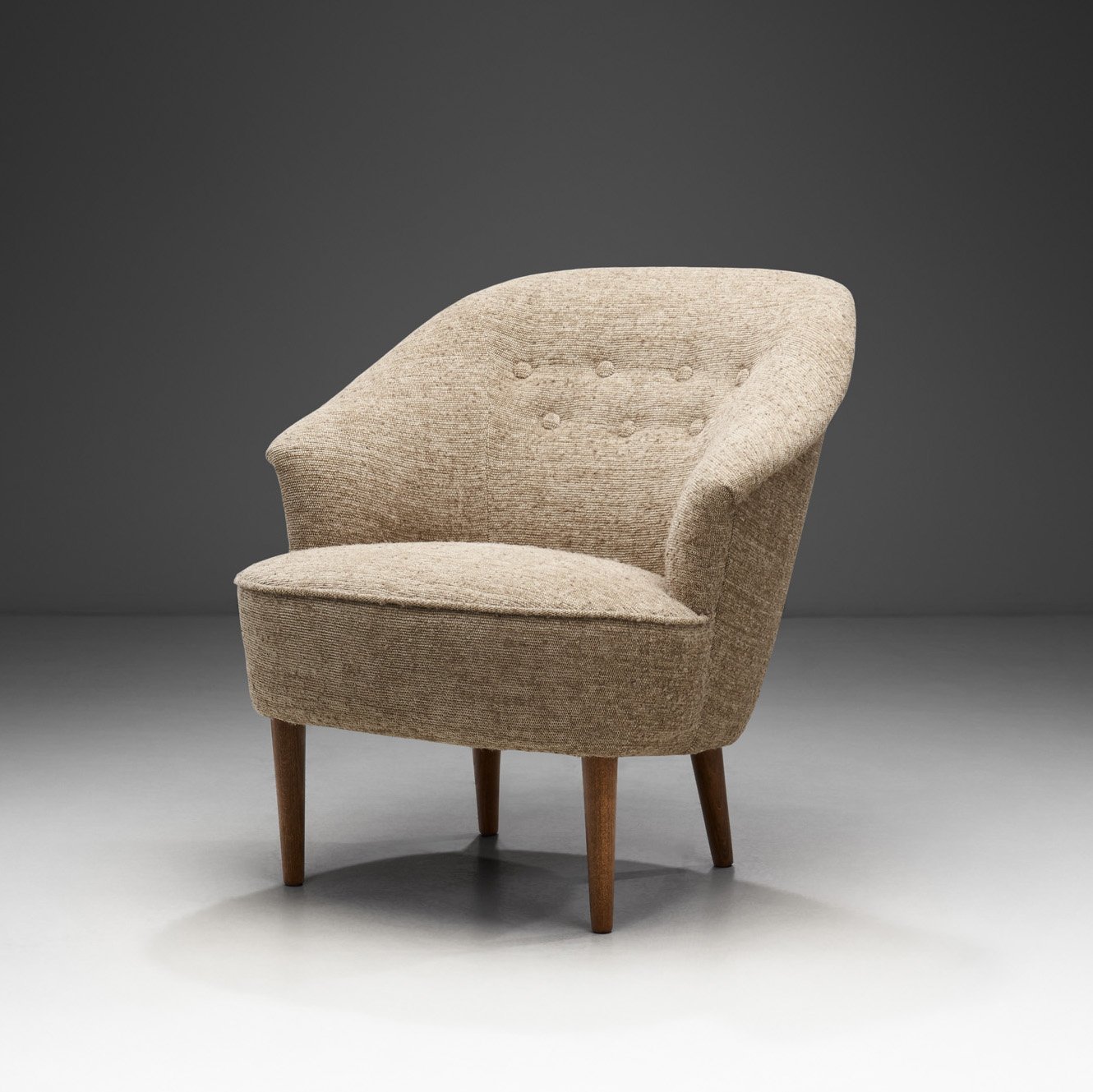Swedish Modern Upholstered Armchair by Axel Larsson (attr.), Sweden ca 1950s














Swedish Modern Upholstered Armchair by Axel Larsson (attr.), Sweden ca 1950s
REQUEST PRICE HERE
Price category: 2,500 - 5,000 usd / eur
Axel Larsson was an incredibly productive Swedish furniture architect and designer with a more than 50-year long career. This armchair is a rarity, despite Larsson being most well-known for his furniture series designed for and mass-produced by SMF Bodafors.
This particular chair takes inspiration from the uplifting, pared-down aesthetic of Scandinavian design. The design consists of a smooth sculptural frame crafted in curved and stained wood that frames a finely tailored seat and back. The streamlined design of the wood structure immediately stands out for its pronounced lines and airy construction. It shows off the architectural precision put into both the design and into the execution. The curve of the arms and legs - formed of a single piece of wood - defines the look and is perfectly balanced by the straight stretchers connecting the legs. The other defining feature is the obtuse angle created by the reclined position of the back and the raised seat. This angle is also followed by the frame and as a result the aesthetic is dynamic but still exudes the functional cosiness of Swedish design. There is a clear emphasis on comfort, from the tilted back to the sculpted, wide armrests and the seat cushion. The light upholstery complements that dark stained wood by creating an apparent contrast both in colour and texture. Axel Larsson also designed furniture for individual carpenters in Stockholm; these were made in small numbers, and this armchair may be one of these rare designs.
Swedish Modern style is delicately scaled, using tapering legs and clever but simple solutions as seen on this chair as well. Subtitled “A Movement Towards Sanity in Design”, it also describes quality and the ability to lend grace to the daily chores of life.
Condition:
In good vintage condition. Wear consistent with age and use. The chair has been reupholstered recently in a premium fabric. Each of our items can be re-upholstered by our in-house atelier in a fabric of choice. Please reach out for more information.
Dimensions:
25.59 in W x 30.31 in D x 30.9 in H; Seat height 21.65 in; Arm height 25.19 in
65 cm W x 77 cm D x 78.5 cm H; Seat height 55 cm; Arm height 64 cm
About the Designer:
Axel Larsson was born in 1898 in Torp socken, Sweden. Larsson was a professional for more than 50 years and belonged to a handful of furniture and interior designers who played a major role and influenced the development of their professional sphere.
He grew up in Medelpad, and as a young carpenter's apprentice, he was given the opportunity to study further in Stockholm as a furniture designer through a scholarship from 1916 to 1920. In parallel with his studies at the Higher School of Art and Design, he was a furniture designer under Carl Malmsten during his work with furniture for Stockholm City Hall. During the 1920s, he made study trips to Europe, including the Paris Exhibition of 1925. Larsson started his own business in 1956, but continued working for the Swedish furniture factories in Bodafors. At this time, he also designed furniture for other companies, such as Balzar Beskow AB.
Larsson was an old-fashioned person in the sense that he did not strive to be seen himself. He was employed for 30 years at Svenska Möbelfabrikerna in Bodafors, which was seldom interested in marketing the individual designer but rather the company. When Larsson collaborated with building architects, the situation was the same. Likewise, his philosophy was that the expediency of a piece of furniture was essential, not a startling form. Even though he was not a pure-minded functionalist, the function was always in focus for his furniture and interior design. Furniture from his first major furniture series was shown at the Stockholm Exhibition in 1930. He created a high number of pieces of furniture and many significant furnishings for public premises. His major projects included Gothenburg Concert Hall, Park Avenue Hotel in Gothenburg and Folksamhuset at Skanstull in Stockholm.
A large part of his sketches and drawings are preserved in the Design Archive at Pukeberg glassworks, and he is represented at, among others, the National Museum in Stockholm and the Röhsska Museum in Gothenburg. ~H.












